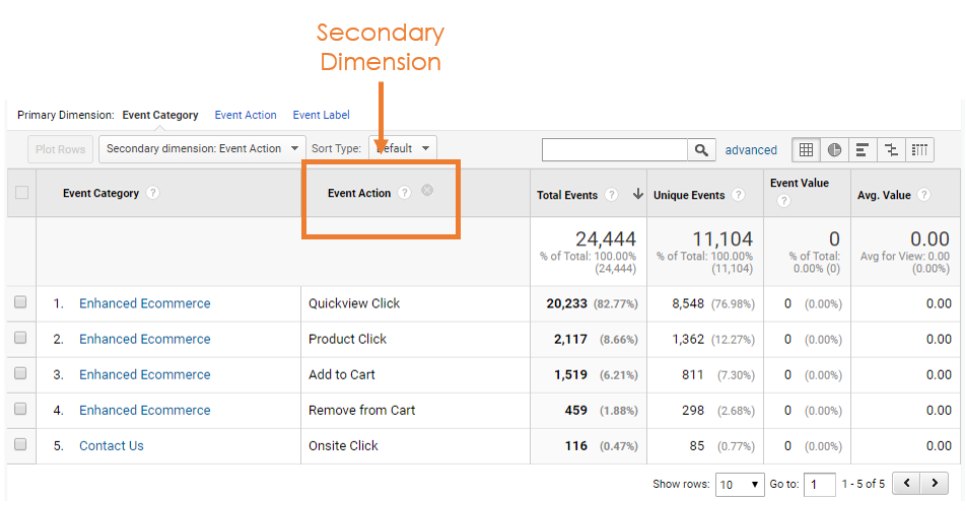Optimizing Data Interpretation: Google Analytics Secondary Dimension Explained
Wiki Article
Unlocking the Power of Additional Dimension Analytics for Improved Data Insights and Decision-Making
In the world of information analytics, key dimensions often take the spotlight, but truth depth of understandings exists within the world of second measurements. These added data points provide a nuanced point of view that can brighten partnerships and patterns not easily apparent initially glance. By taking advantage of the power of second measurement analytics, organizations can introduce surprise trends, discover relationships, and extract much more meaningful verdicts from their information. The capacity for boosted decision-making via the usage of these secondary dimensions is huge, assuring a deeper understanding of complicated data collections and leading the way for even more educated critical selections.
Relevance of Second Measurements
Discovering the importance of additional measurements in analytics reveals the surprise layers of information insights critical for informed decision-making in various domain names. Second measurements provide a deeper understanding of primary data by offering extra context and point of views. By incorporating secondary measurements right into analytics, companies can draw out a lot more nuanced and comprehensive insights from their datasets.One secret relevance of additional measurements is their capability to segment and categorize main data, permitting an extra comprehensive analysis of details subsets within a dataset. When looking at the data as a whole, this division enables organizations to determine patterns, fads, and outliers that may not be evident. Moreover, secondary dimensions aid in revealing relationships and reliances between different variables, bring about more precise forecasting and anticipating modeling.
Furthermore, second measurements play a vital function in enhancing information visualization and reporting. By adding additional dimensions to visualizations, such as graphes or charts, experts can develop extra useful and insightful depictions of information, promoting far better interaction of searchings for to stakeholders. On the whole, the assimilation of second measurements in analytics is instrumental in opening the complete possibility of information and driving evidence-based decision-making.
Secret Advantages of Using Additional Dimensions
Utilizing second dimensions in analytics offers companies a strategic benefit by augmenting the depth and granularity of information understandings. By studying data utilizing secondary dimensions such as time, location, gadget kind, or individual demographics, companies can reveal patterns, trends, and correlations that might otherwise stay covert.In addition, the utilization of secondary dimensions boosts the context in which main information is interpreted. It supplies an extra extensive sight of the relationships between different variables, enabling companies to make informed decisions based upon a much more alternative understanding of their data. In addition, additional measurements help with the identification of outliers, abnormalities, and areas for optimization, eventually resulting in a lot more reliable approaches and enhanced end results. By leveraging secondary measurements in analytics, organizations can harness the complete potential of their data to drive far better decision-making and accomplish their company goals.
Advanced Data Analysis Techniques
A deep study advanced information evaluation strategies exposes innovative techniques for drawing out valuable insights from intricate datasets. One such method is maker understanding, where algorithms are used to identify patterns within information, anticipate outcomes, and make data-driven choices. This technique enables the automation of logical design building, making it possible for the processing of huge volumes of information at a faster rate than standard methods.One more innovative method is predictive analytics, which makes use you can check here of statistical algorithms and machine understanding techniques to forecast future outcomes based on historical data. By evaluating patterns and patterns, companies can expect customer habits, market patterns, and potential risks, equipping them to make proactive decisions.
Furthermore, text mining and sentiment evaluation are important techniques for extracting understandings from disorganized data resources such as social networks comments, customer evaluations, and study reactions. By assessing message information, organizations can recognize consumer viewpoints, recognize arising fads, and enhance their items or solutions based upon feedback.
Enhancing Decision-Making Through Additional Measurements

Enhancing decision-making via second measurements makes it possible for companies to make even more informed and targeted strategic options. By segmenting customer information based on secondary measurements like purchasing background or interaction degrees, firms can customize their advertising approaches to specific audience sectors, leading to enhanced conversion rates and client fulfillment. Additional measurements can aid determine correlations and connections between various variables, enabling organizations to make data-driven decisions that drive growth and profitability.
Executing Additional Dimension Analytics
When including additional dimensions in additional info analytics, companies can open deeper understandings that drive critical decision-making and boost overall efficiency. This entails recognizing the details questions the company looks for to respond to and the information factors required to address them.Additionally, organizations need to take advantage of advanced analytics tools and innovations to streamline the process of integrating additional dimensions. These devices can automate information processing, analysis, and visualization, enabling companies to concentrate on analyzing understandings instead than hand-operated information adjustment.
Verdict
In final thought, additional measurement analytics play a vital function in boosting data understandings and decision-making procedures. By using advanced information evaluation methods and applying second measurements efficiently, organizations can unlock the power of their information to drive tactical company decisions.In the world of data analytics, key dimensions frequently take the spotlight, yet the real depth of understandings lies within the realm of secondary dimensions.Utilizing second measurements in analytics supplies companies a critical advantage by increasing the depth and granularity of information understandings. By leveraging additional dimensions in analytics, organizations can harness the full potential of their information to drive much better decision-making and accomplish their company goals.
Carrying out data recognition procedures and normal audits can help preserve information quality and reliability.
By making click to investigate use of innovative information evaluation methods and applying additional measurements effectively, companies can unlock the power of their data to drive critical organization choices.
Report this wiki page